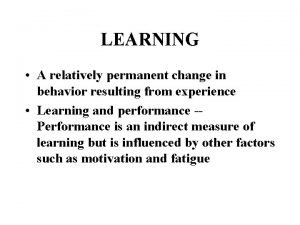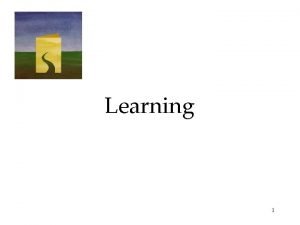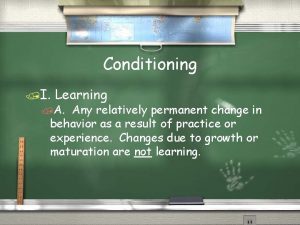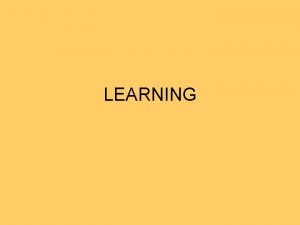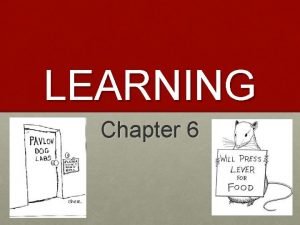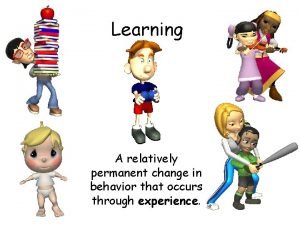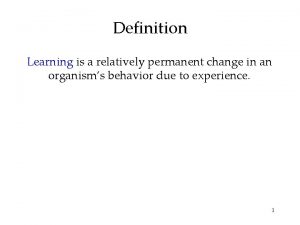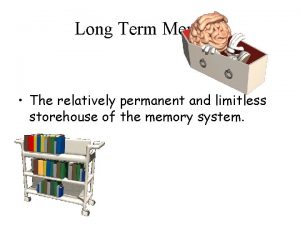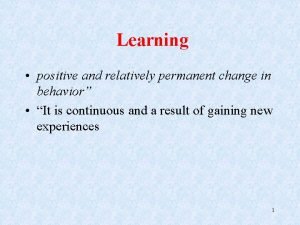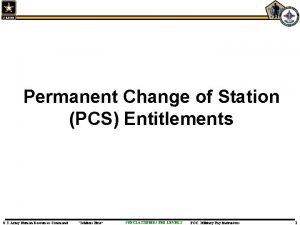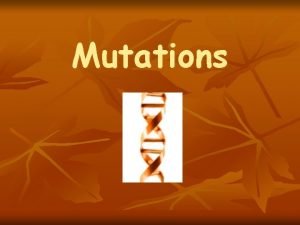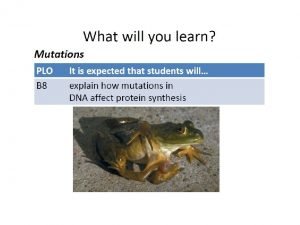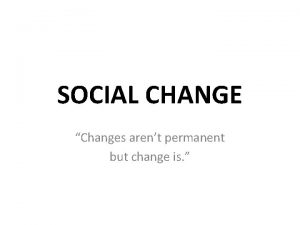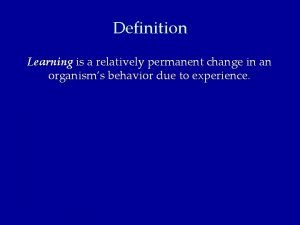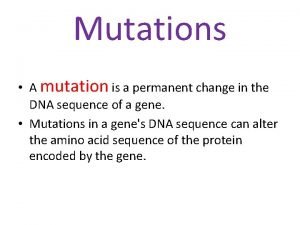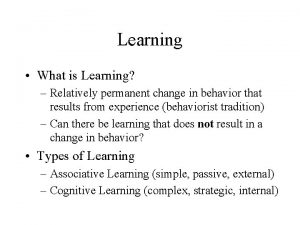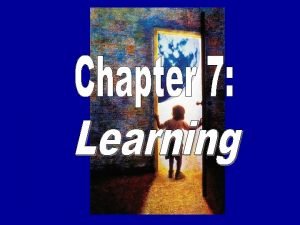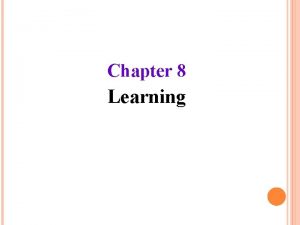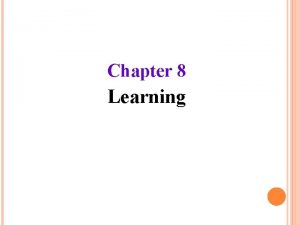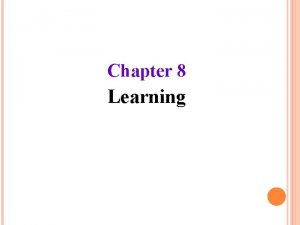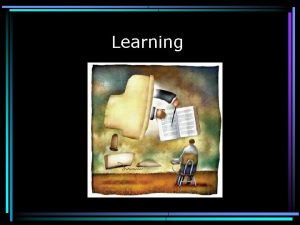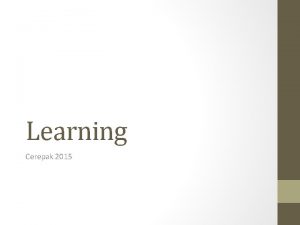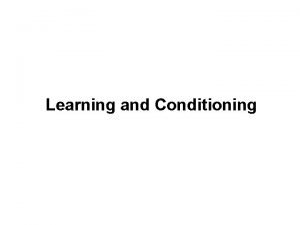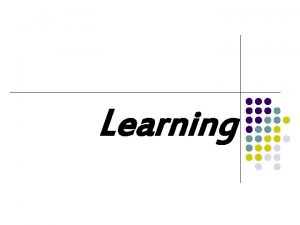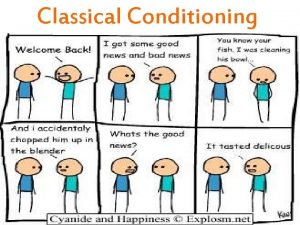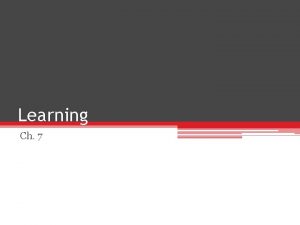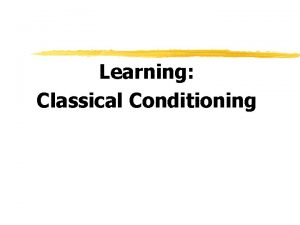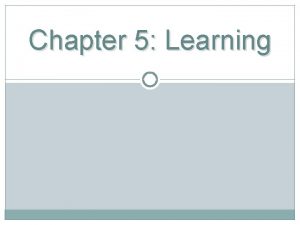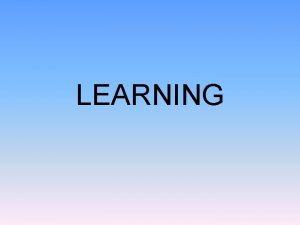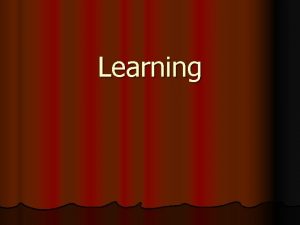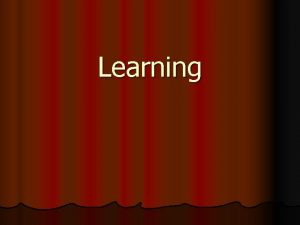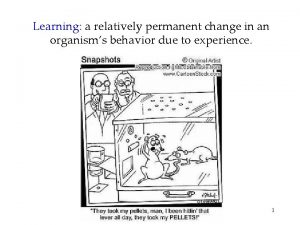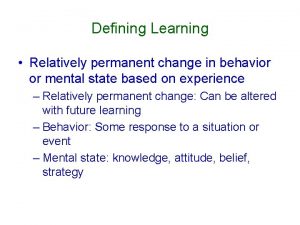Learning What is Learning Relatively permanent change in






























- Slides: 30

Learning • What is Learning? – Relatively permanent change in behavior that results from experience (behaviorist tradition) – Can there be learning that does not result in a change in behavior? • Types of Learning – Associative Learning (simple, passive, external) – Cognitive Learning (complex, strategic, internal)

Associative Learning • Classical Conditioning – associating two stimuli • Operant Conditioning – associating a behavior and its consequences


Classical Conditioning • Pavlov’s serendipitous discovery • Associating 2 stimuli – The first stimulus is “neutral” – does not produce any response – The second stimulus produces a reflex (unconditioned) response • After the 2 stimuli become associated, both will produce the unconditioned response

Pavlovian Classical Conditioning Before Conditioning UCS UCR Neutral Stimulus No Response During Conditioning CS UCR After Conditioning CS CR

Pavlovian Classical Conditioning Before Conditioning Food (UCS) Salivation (UCR) Tone (NS) No Salivation During Conditioning Tone (CS) Food (UCS) Salivation (UCR) After Conditioning Tone (CS) Salivation (CR)

Classical Conditioning to Cure Bed-Wetting Before Conditioning Alarm (UCS) Wake up (UCR) Full Bladder (NS) No waking up During Conditioning Full B. (CS) Alarm (UCS) Wake up (UCR) After Conditioning Full Bladder (CS) Wake up (CR)

Further Concepts that Apply to Classical Conditioning • Generalization: CR is given to stimuli that are similar to the CS • Discrimination: CR not given to stimuli that are dissimilar to the CS • Extinction: If the CS is presented repeatedly without being followed by the UCS, the CR will diminish or cease • Spontaneous Recovery: Following extinction, the CR will spontaneously re-appear after a delay

Classical Conditioning as Simple Associative Learning • Temporal Contiguity was thought to be sufficient – the CS simply needs to occur immediately prior to the UCS for conditioning to take place • Equipotentiality: any two stimuli could be associated through conditioning

Equipotentiality Falsified • Some stimuli are easier to associate than others • Taste Aversion – only foods become associated with illness, not other stimuli – Garcia & Koelling, 1966 – the “Sweet, bright, noisy water study”

Garcia & Koelling, 1966 • CS = flavor, light, and click (sweet, bright, noisy water) • UCS: 2 conditions – Group 1: UCS = illness (from X-rays) – Group 2: UCS = shock • CR = avoidance (not drinking the water) • After conditioning, tested which features of the CS were associated with each UCS

Garcia & Koelling: Results • Both Groups: CS (sweet, bright, noisy) CR (avoidance) • Group 1(UCS = shock) – Sweet water No avoidance – Bright noisy water Avoidance • Group 2 (UCS = illness) – Sweet water Avoidance – Bright noisy water No avoidance

Temporal Contiguity is Not Enough • Contingency: The CS must reliably predict the occurrence of the UCS (Rescorla, 1966) • Informativeness: The CS must provide new information for predicting the occurrence of the UCS

Contingency (Rescorla, 1966) • UCS = shock (S), UCR = fear • CS = tone (T) • Training: two conditions – Random Condition: S TS S T TS – Contingent Condition: TS • Results: Rats learned to fear the tone only in the contingent condition, when the tone predicted the shock

Informativeness: Blocking • If an organism has already learned that one CS predicts the UCS, that will block the conditioning of a new CS if the new CS does not provide any additional information • Example: Fear conditioning of a tone blocks conditioning of a light

Blocking Training 1 Training 2 Test -none- Tone & Light, shock (CR = fear) Light Fear Tone, shock (CR = fear) Tone & Light, shock (CR = fear) Light No Fear

Rescorla-Wagner Model (1972) • A mathematical model of the “strength of association” produced in classical conditioning • Can account for all of the classical conditioning phenomena we have just seen • Uses just one single equation!

Rescorla-Wagner Model ΔVn = c (Vmax – Vn) V = the strength of association between a CS and a US ΔVn = the change in the strength of association between the CS and US on a given trial Vmax = the asymptote for CS-US association strength after learning c = rate of conditioning (how fast the association is learned)


Cognitive Interpretation of Classical Conditioning • Classical Conditioning is more than simple association • The concept of information could explain contingency and blocking • They are not just associating stimuli, they are seeking information from one stimulus to predict the occurrence of the other

Operant Conditioning • The law of effect: behaviors that are followed by good things happen more often • Association: Things that occur together become associated

Basics of Operant Conditioning • Operant – freely emitted behavior operating on the organism’s environment; NOT a reflex response • Reinforcement Contingencies – the consequences that follow a behavior – Reinforcement: increases the frequency of the behavior – Punishment: decreases frequency of behavior

Reinforcement & Punishment • • Positive reinforcement Negative reinforcement Positive punishment Negative punishment

Reinforcement Schedules • • Continuous vs. Partial Fixed vs. Variable Interval vs. Ratio Examples – Fixed ratio: vending machine – Variable ratio: slot machine – Fixed interval: checking mailbox – Variable interval: checking email

Explaining Complex Learning with Operant Conditioning • Secondary reinforcers - association • Shaping – simple learning in small increments • Chaining – small increments plus secondary reinforcement • Language – association and reinforcement (Skinner’s Verbal Behavior, 1957)

Learning that Could not be Explained by Behaviorism • Latent Learning – learning without reinforcement (Tolman & Honzig, 1930) • Observational Learning – learning without behaving or being reinforced (Bandura, 1977) • Overjustification – when rewards decrease the frequency of behavior (but see Eisenberger & Cameron, 1996 for an opposing view) • Language Acquisition – Chomsky’s critique

Latent Learning Tolman & Honzig, 1930 Group 1: never a food reward Group 2: always a food reward Group 3: food reward after 10 days

Behaviorism Falls Short: Language • Chomsky: “Action in the past” as a property of stimuli is sneaking mental representations in the back door • Association is insufficient to explain language learning: The evidence points to learning RULES • Evidence: Over-regularization (“goed”) • Conclusion: Mere associations between words can not explain language; any adequate theory of meaning must hypothesize internal representations of the rules of language (grammar)

So What was Behaviorism Lacking? • Symbolic Representation – we have internal (mental) representations for things in the external world • Structure – we learn sets of rules for combining symbols (e. g. , grammar), not just associations between pairs of symbols

Associative Learning Rises Again? • LSA – Latent Semantic Analysis – A theory of meaning, and a method for computer analysis of the meanings of texts – The meaning of a word = all of the words that co-occur with it in a sample of written text (roughly) – Meaning is just a function of associations of words, not structure (syntax) – How much of language meaning can LSA account for? A surprisingly large amount.
 Relatively permanent change
Relatively permanent change Learning is relatively permanent
Learning is relatively permanent Learning is a relatively permanent change in
Learning is a relatively permanent change in Any relatively permanent change in behavior
Any relatively permanent change in behavior Learning is a permanent change in behavior
Learning is a permanent change in behavior Douglas merritte
Douglas merritte A relatively permanent change of behavior is called
A relatively permanent change of behavior is called Define permanent change
Define permanent change The relatively permanent and limitless storehouse
The relatively permanent and limitless storehouse Relatively permanent
Relatively permanent Jtr 0505
Jtr 0505 Helpful mutation
Helpful mutation Inversion mutation
Inversion mutation Changes aren't permanent but change is
Changes aren't permanent but change is Define permanent change
Define permanent change Permanent change in dna sequence
Permanent change in dna sequence Learning is permanent
Learning is permanent Learning is permanent
Learning is permanent Cuadro comparativo e-learning m-learning b-learning
Cuadro comparativo e-learning m-learning b-learning Is cutting paper a physical change
Is cutting paper a physical change Chemical change examples
Chemical change examples Absolute change and relative change formula
Absolute change and relative change formula Keep change change integers
Keep change change integers Difference between physical and chemical change
Difference between physical and chemical change Difference between supply and quantity supplied
Difference between supply and quantity supplied Change in supply and change in quantity supplied
Change in supply and change in quantity supplied Enagic founder
Enagic founder Reactive change is change that
Reactive change is change that What is example of physical change
What is example of physical change Spare change physical versus chemical change
Spare change physical versus chemical change Rocks change due to temperature and pressure change
Rocks change due to temperature and pressure change
